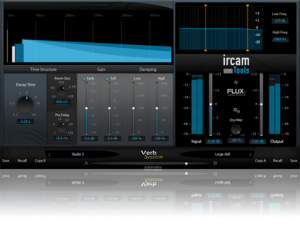FLUX Releases IRCAM Verb Session and IRCAM HEar
FLUX is a French plugin design company involved in audio and picture that are dedicated to adding the human element through their plug-ins with simplicity and sophistication. Back in March, FLUX announced their partnership with another French company – the Institute for Research and Coordination in Acoustics and Music (IRCAM). This development has spawned two of their latest plug-ins – IRCAM Verb Session and IRCAM HEar.
In short, the IRCAM Verb Session is a reverb tool with an interface designed for fast-paced work flow – recording, broadcast and mixing sessions in particular – while still maintaining acoustical design features of the original IRCAM Verb. The IRCAM HEar is a binaural encoding tool that allows the user to faithfully monitor a surround sound mix when a surround sound monitoring setup isn’t an option.
Both of these tools are available now for Mac OS X and Windows as RTAS, VST or AU with IRCAM Verb Session priced at $156 and IRCAM HEar priced at $51.
For more detailed information about these two new plug-ins from FLUX, read on:
IRCAM VERB Session
VERB Session is based on the same fine technology used in the acclaimed IRCAM VERB algorithmic room acoustics and reverberation processor, with a modular construction employing a recursive filtering reverb engine, reproducing and synthesizing the specific acoustical characteristics of any spatial sound environment, developed utilizing the results of over a decade of intense research by the Acoustic and Cognitive Spaces Team at the IRCAM R&D centre in Paris.
Tailored for simplicity, with a fast paced workflow well-suited for situations where the perfect result has to be achieved within seconds, VERB Session presents the ultimate solution whether you are a seasoned session engineer or a demanding broadcast and post-production mixer.
HEar – Binaural Encoding Tool
HEar provides faithful reproduction of a stereo or surround mix with a pair of conventional stereo headphones. It relies on proven technology to model the various phenomena that occur when playing back audio material through a loudspeaker system.
This allows monitoring a full surround mix in situations when a surround-capable environment is not available or practical. Another typical use of HEar is doing precise checking of a mix, which is convenient with headphones as these provide a ‘surgical’ and very detailed, microscope-like rendering of the audio. HEar can also prove very useful in a project studio context, and whenever noise isolation is a concern, as it helps achieving a more realistic sound environment.
Binaural Technology
Binaural technology encompasses methods for recording, processing, synthesizing and reproducing sound that are specifically designed to preserve tridimensional localisation properties.
In order to mimic the impression of a sound originating from a given incidence, it is sufficient to filter a mono signal, which on its own lacks any kind of spatial information, with both left and right HRTF filters. This constitutes the foundation of binaural synthesis.
Please note that the resulting signal is only meant to be listened to with headphones, and isn’t designed for a conventional stereo loudspeaker setup.
Please note: When you buy products through links on this page, we may earn an affiliate commission.







